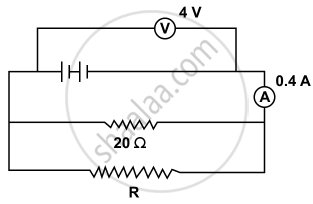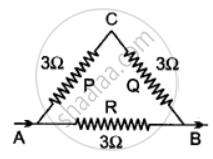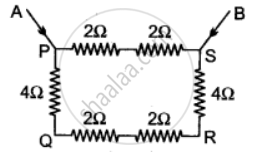Advertisements
Advertisements
Question
Three resistors of 6Ω, 4Ω and 4Ω are connected together so that the total resistance is 8Ω. Draw a diagram to show this arrangement and give reason to justify your answer.
Solution

In parellel,
`1/"R'" = 1/4 + 1/4`
R' = `4/2` = 2Ω
In series, R = R' + R"
2Ω + 6Ω = 8Ω
APPEARS IN
RELATED QUESTIONS
How many 176 Ω resistors (in parallel) are required to carry 5 A on a 220 V line?
State the law of combination of resistances in parallel.
Explain with diagram what is meant by the "series combination" and "parallel combination" of resistances. In which case the resultant resistance is : (i) less, and (ii) more, than either of the individual resistances?
Four resistors each of resistance 2Ω are connected in parallel. What is the effective resistance?
In the following figure calculate:
- the total resistance of the circuit
- the value of R, and
- the current flowing in R.

Solve the following question:
In an electric circuit, two resistors of 12 0 each are joined in parallel to a 6 V battery. Find the current drawn from the battery.
Calculate equivalent resistance in the following cases:


Two resistors when connected in parallel give the resultant resistance of 2 ohms, but when connected in series the effective resistance becomes 9 ohms. Calculate the value of each resistance.
Two resistors of resistances 2 Ω and 3 Ω are connected in parallel to a cell to draw current 0.5 A from the cell. Draw a labelled diagram of the arrangement
Two resistors of resistance 2 Ω and 3 Ω are connected in parallel to a cell to draw current 0.5 A from the cell. Calculate the current in each resistor.
